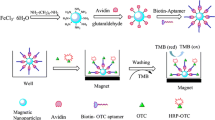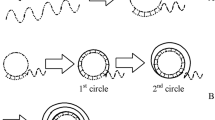Abstract
To detect sulfamethazine (SMZ) residues in edible animal products, a colorimetric aptasensor that is based on indirect competitive enzyme-linked aptamer assay (ELAA) is developed in this study. This ELAA uses SMZ-specific aptamers as recognition elements and enzyme as the signal readout element. The detection sensitivity and the specificity of the ELAA were investigated. Our results showed that the indirect competitive ELAA had a ultrasensitivity with a low detection limit of 0.05 ng mL−1. In addition, the proposed indirect competitive ELAA exhibited an 50% inhibition concentration value of 0.64 ng mL−1 for SMZ, and recoveries up to 80.5–92.3% with coefficients of variation of less than 10%. Furthermore, when the ELAA was used for incurred samples by detecting SMZ in chicken muscles, the results obtained by the ELAA methods showed a good agreement with those obtained by established TRFIA and HPLC methods. These results demonstrate that the proposed indirect competitive ELAA can be efficiently used with good accuracy and precision, providing a simple method for the detection of SMZ residue in animal tissues.




Similar content being viewed by others
References
Chen R, Li H, Zhang H, Zhang S, Shi W, Shen J, Wang Z (2013) Development of a lateral flow fluorescent microsphere immunoassay for the determination of sulfamethazine in milk. Anal Bioanal Chem 45:6783–6789
Chen Y, Guo L, Liu L, Song S, Kuang H, Xu C (2017) Ultrasensitive immunochromatographic strip for fast screening of 27 sulfonamides in honey and pork liver samples based on a monoclonal antibody. J Agric Food Chem 65:8248–8255
Clark S, Turnipseed S, Madson M, Hurlbut J, Kuck L, Sofos J (2005) Confirmation of sulfamethazine, sulfathiazole, and sulfadimethoxine residues in condensed milk and soft-cheese products by liquid chromatography/tandem mass spectrometry. J AOAC Int 88:736–743
Cratacos-Cubarsi M, Castellari M, Garcia-Regueiro J (2006) Detection of sulphamethazine residues in cattle and pig hair by HPLC-DAD. J Chromatogr B 832:121–126
Ding S, Chen J, Jiang H, He J, Shi W, Zhao W, Shen J (2006) Application of quantum dot-antibody conjugates for detection of sulfamethazine residue in chicken muscle tissue. J Agric Food Chem 54:6139–6142
Font G, Juan-Garcia A, Pico Y (2007) Pressurized liquid extraction combined with capillary electrophoresis-mass spectrometry as an improved methodology for the determination of sulfonamide residues in meat. J Chromatogr A 1159:233–241
Furusawa N (2003) A clean and rapid liquid chromatographic technique for sulfamethazine monitoring in pork tissues without using organic solvents. J Chromatogr Sci 44:377–380
Guo Y, Ngom B, Le T, Jin X, Wang L, Shi D, Wang X, Bi D (2010) Utilizing three monoclonal antibodies in the development of an immunochromatographic assay for simultaneous detection of sulfamethazine, sulfadiazine, and sulfaquinoxaline residues in egg and chicken muscle. Anal Chem 82:7550–7555
He J, Shen J, Suo X, Jiang H, Hou X (2005) Development of a monoclonal antibody-based ELISA for detection of sulfamethazine and N4-acetyl sulfamethazine in chicken breast muscle tissue. J Food Sci 70:C113–C117
He J, Wang S, Fang G, Zhu H, Zhang Y (2008) Molecularly imprinted polymer online solid-phase extraction coupled with high-performance liquid chromatography−UV for the determination of three sulfonamides in pork and chicken. J Agric Food Chem 56:2919–2925
Le T, Yan P, Liu J, Wei S (2013) Simultaneous detection of sulfamethazine and sulfaquinoxaline using a dual-label time-resolved fluorescence immunoassay. Food Addit Contam A 30:1264–1269
Lee HJ, Lee MH, Han IK (2001) Application of ELISA for the detection of sulfamethazine residue in live cattle. Asian-Australas J Anim Sci 14:378–381
Li X, Zhang G, Liu Q, Feng C, Wang X, Yang Y, Xiao Z, Yang J, Xing G, Zhao D, Cai S, Chen H (2009) Development of immunoassays for the detection of sulfamethazine in swine urine. Food Addit Contam A 26:314–325
Liu X, Gao T, Gao X, Ma T, Tang Y, Zhu L, Li J (2017) An aptamer based sulfadimethoxine assay that uses magnetized upconversion nanoparticles. Microchim Acta 184:3557–3563
Lv Z, Chen A, Liu J, Guan Z, Zhou Y, Xu S, Yang S, Li C (2014) A simple and sensitive approach for ochratoxin a detection using a label-free fluorescent aptasensor. PLoS One 9:e85968. https://doi.org/10.1371/journal.pone.0085968
Ma M, Wen K, Beier RC, Eremin SA, Li C, Zhang S, Shen J, Wang Z (2016) Chemiluminescence resonance energy transfer competitive immunoassay employing hapten-functionalized quantum dots for the detection of sulfamethazine. ACS Appl Mater Interfaces 8:17745–17750
Mohammad DN, Ramezani M, Sarreshtehdar EA, Abnous K, Taghdisi SM (2016) A novel electrochemical aptasensor based on arch-shape structure of aptamer-complimentary strand conjugate and exonuclease I for sensitive detection of streptomycin. Biosens Bioelectron 75:123–128
Spielmeyer A, Ahlborn J, Hamscher G (2014) Simultaneous determination of 14 sulfonamides and tetracyclines in biogas plants by liquid-liquid-extraction and liquid chromatography tandem mass spectrometry. Anal Bioanal Chem 40:2513–2524
Sun Y, Xu J, Li W, Cao B, Wang DD, Yang Y, Lin QX, Li JL, Zheng TS (2014) Simultaneous detection of ochratoxin a and fumonisin B1 in cereal samples using an aptamer−photonic crystal encoded suspension array. Anal Chem 86:11797–11802
Wang X, Li K, Shi D, Xiong N, Jin X, Yi J, Bi D (2007) Development of an immunochromatographic lateral-flow test strip for rapid detection of sulfonamides in eggs and chicken muscles. J Agric Food Chem 55:2072–2078
Wang S, Yong W, Liu J, Zhang L, Chen Q, Dong Y (2014) Development of an indirect competitive assay-based aptasensor for highly sensitive detection of tetracycline residue in honey. Biosens Bioelectron 57:192–198
Wu S, Duan N, Wang Z, Wang H (2011) Aptamer-functionalized magnetic nanoparticle-based bioassay for the detection of ochratoxin a using upconversion nanoparticles as labels. Analyst 136:2306–2314
Xiao C, Chen F, Liu Z, Zhang Y, Chen C, Chen H, Zhou H, Gao Z (2012) Ultrasound-assisted extraction combined with HPLC-UV for fast determination of sulfamethazine and its n4-acetyl metabolite in plasma and phosphate buffer. Anal Lett 45:1836–1848
Xu ZL, Shen YD, Sun YM, Campbell K, Tian YX, Zhang SW, Lei HT, Jiang YM (2013) Novel hapten synthesis for antibody production and development of an enzyme-linked immunosorbent assay for determination of furaltadone metabolite 3-amino-5-morpholinomethyl-2-oxazolidinone (AMOZ). Talanta 103:306–313
Yan X, Cao Z, Lau C, Lu J (2010) DNA aptamer folding on magnetic beads for sequential detection of adenosine and cocaine by substrate-resolved chemiluminescence technology. Analyst 135:2400–2407
Funding
The work was supported by the National Natural Science Foundation of China (Grant No. 31671939), China Scholarship Council (CSC No. 201608505051), and Chongqing Normal University.
Author information
Authors and Affiliations
Corresponding authors
Ethics declarations
Conflict of Interest
Tao Le declares that he has no conflict of interest. Qi Sun declares that he has no conflict of interest. Yong Xie declares that he has no conflict of interest. Lihui Shu declares that she has no conflict of interest. Jin Liu declares that she has no conflict of interest. Jian Xu declares that he has no conflict of interest. Jin Xiong declares that he has no conflict of interest. Xudong Cao declares that he has no conflict of interest.
Ethical Approval
This article does not contain any studies with human subjects. All animal experiments that were described in the present study were performed in adherence to Chongqing Normal University Animal Experiment Center Guidelines and approved by the Animal Ethics Committee.
Informed Consent
Not applicable.
Rights and permissions
About this article
Cite this article
Le, T., Sun, Q., Xie, Y. et al. A Highly Sensitive Aptasensor for Sulfamethazine Detection Using an Enzyme-Linked Aptamer Assay. Food Anal. Methods 11, 2778–2787 (2018). https://doi.org/10.1007/s12161-018-1258-2
Received:
Accepted:
Published:
Issue Date:
DOI: https://doi.org/10.1007/s12161-018-1258-2




